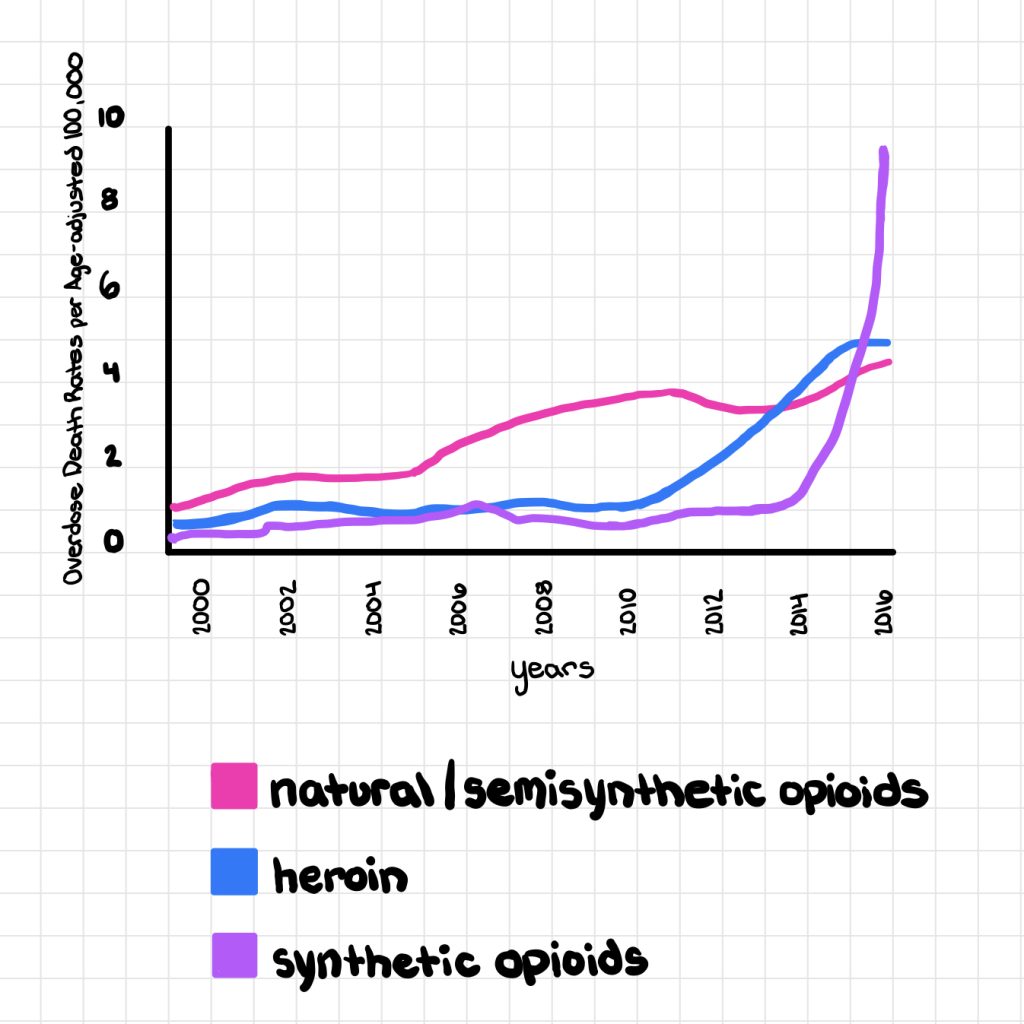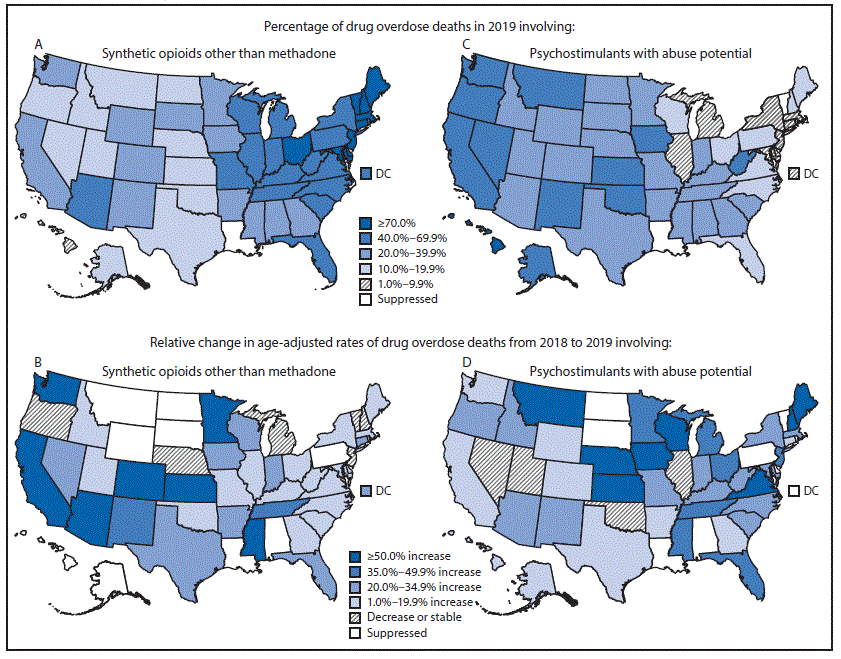18 Drug Cutting Agents in Synthetic Opioids
Allyson Woolbert
The Synthetic Drug Epidemic History
The history of the modern synthetic drug epidemic can be tracked through three waves ranging from the 1990s to the present: prescription opioids, heroin, and synthetic opioids (Gardner et al., 2022). The overconsumption of opioids increased when Purdue Pharma, a private pharmaceutical company operated by the Sackler family, brought a new prescription painkiller to the market known as OxyContin. This painkiller would quickly become the most prescribed opioid in the mid-1990s (Gardner et al., 2022). Extensive marketing of Oxycontin as a pain treatment given to all physicians, pharmacists, and nurses caused overprescription of these opioids. The hardest hit areas included the Appalachian Region and the Northeast. In 2005, the National Survey on Drug Use and Health connected the initial use of OxyContin to continued drug abuse (Gardner et al., 2022). Following the publication of this study, Purdue Pharma created a new abuse-deterrent formula called OxyAR, and the distribution of OxyContin ceased (Ciccarone, 2019). By 2006, several states had more yearly prescriptions for opioids than people.
Significant reductions in prescribing opioids and the development of OxyAR forced many patients with opioid dependency into searching for more readily available drug options such as heroin (Ciccarone, 2019). Heroin provided an affordable alternative with high purity. In 2011, heroin overdoses began to skyrocket in the younger age group of 20-34, while prescription opioid overdoses were mainly seen in adults aged 50-64 (Ciccarone, 2019). Young adults, now the biggest consumers of heroin, most often purchase their supply from Colombia and Mexico shipments. Colombian heroin is seen mainly in the Northeast, while black tar heroin from Mexico is predominantly in the West. Increasing demand for heroin and opioids has led to the current issue of synthetic opioids in the US (Ciccarone, 2019).

What is a Synthetic Opioid?
Synthetic opioids are drugs made in a lab. These drugs are typically smuggled into the country from Mexico and China (Drug Enforcement Administration [DEA], 2019). Some of the most common drugs within this category are fentanyl and tramadol. Fentanyl is known for its high potency and poisoning (DEA, 2019). Since these drugs are so potent, only small doses are needed to induce a high. The trend of adding cutting agents to drugs has become wildly popular (Sunrise House Treatment Center, 2022). A cutting agent is a less expensive substance added to a drug to dilute the purity or enhance the effect. These agents allow the supplier to stretch the number of drugs produced, thus making more money (Sunrise House Treatment Center, 2022). The cutting agents sometimes work to increase the high (Singh et al., 2020). Only small amounts of the pure drug are put into the supply, allowing suppliers to mass produce impure drugs cheaply. With a 45% increase in synthetic opioid deaths from 2016 to 2017, these illicit drugs are now a driving force behind the opioid crisis (Singh et al., 2020).
What Cutting Agents are in Synthetic Opioids?
Within these illicit drugs, there are a multitude of cutting agents. In 2021, a study in the United States analyzed roughly 6000 street samples, and the results determined that pure drugs only accounted for less than 0.1% of the samples (Żubrycka et al., 2022). Getting a pure, uncut drug is nearly impossible, and the cutting agents added in range from basic household items to pharmacologically active components. Popular agents include caffeine, levamisole, xylazine, lidocaine, fentanyl, baby powder, aspirin, gasoline, hydrochloric acid, household cleaners, and rat poison (Singh et al., 2020; Sunrise House Treatment Center, 2022; Villa, 2023).
How Do Cutting Agents Affect the Body?
Agents like the previous substances listed impact the body differently and are used for different reasons. A recent study conducted in Vermont and Kentucky tested 500 different street samples, most of which included caffeine and levamisole (Singh et al., 2020). Caffeine is a stimulant whose powder form looks similar in color and texture to many illicit drugs. Caffeine, as a cutting agent, masks the signs of overdose, which is very dangerous (Crane, 2021). Stimulants speed up breathing and heart rate, which counters the usual overdose signs of slow breathing and unconsciousness (Crane, 2021). When caffeine is added to drugs it lowers the vaporizing temperature of drugs, making it easier to inhale via smoking and consequently giving a quicker high (Sunrise House Treatment Center, 2022). Levamisole is a substance used to attack parasitic worms in cattle. When added to drugs, it promotes a prolonged high. It also triggers heart, brain, and lung disease and damages white blood cells. (Solomon & Hayes, 2017).
Recent struggles in Philadelphia deal with a drug-cutting agent known as xylazine. Xylazine, an animal tranquilizer, induces a euphoric effect and prolongs the high after drug injection (Friedman et al., 2022). However, many negative effects on the body, such as skin infection and naloxone resistance, stem from xylazine use. These skin infections usually lead to necrotic tissue, requiring amputation of the arms and legs (Friedman et al., 2022).
Every batch of drugs is produced with different substances. When bulking the product, the sugars and starches added are typically fine for the body in moderation (Sunrise House Treatment Center, 2022). However, other toxic agents pose an extreme danger to someone using a drug. Cutting agents weaken immune systems and lead to heart conditions, skin decay, organ damage and failures, comas, and respiratory issues. One cannot tell what their drug contains (Sunrise House Treatment Center, 2022).

Conclusion
Since drug-cutting agents are very different from batch to batch, chromatography mass spectrometry is the only effective way to determine what is in a sample (Żubrycka et al., 2022). This distinguishes different elements found in the drugs. Unfortunately, this technology is only at specialized labs (Żubrycka et al., 2022). Recently, fentanyl test strips were brought to the market, encouraging safer drug use by testing for fentanyl. Fentanyl is one famous drug-cutting agent. The process is simple, but its harm reduction impact is excellent, significantly reducing the number of fentanyl overdoses (Centers for Disease Control and Prevention, 2023). For a more in-depth look into the history and effects of fentanyl, visit the following chapter. Since drug cutting is a relatively new widespread issue, not enough harm reduction solutions available to the majority have been developed for all the different cutting agents. The future of cutting agents is unclear as drug manufacturers make new changes every day. Cutting agents are dangerous and will continue to pose a threat for as long as illicit drugs are on the market (Sunrise House Treatment Center, 2022).
Review Questions
1. What two regions struggle with both prescription and synthetic opioids?
a. Appalachian and West
b. The South and Midwest
c. Northeast and Appalachian
d. Midwest and West
2. What is the reason that drug manufacturers add cutting agents to their supply?
a. Increase their profit
b. Dilute the purity of the drug
c. Enhance the effect of the drug
d. All of the above
3. True or false: it is easy to determine what cutting agents are in a drug.
a. True
b. False
References
Centers for Disease Control and Prevention. (2023). Fentanyl test strips: A harm reduction strategy. https://www.cdc.gov/stopoverdose/fentanyl/fentanyl-test-strips.html#:~:text=Fentanyl%20test%20strips%20(FTS)%20are,%2C%20powder%2C%20and%20injectables).
Ciccarone D. (2019). The triple wave epidemic: Supply and demand drivers of the US opioid overdose crisis. The International Journal on Drug Policy, 71, 183–188. https://doi.org/10.1016/j.drugpo.2019.01.010
Crane, M. (2021, December 20). What Is heroin cut with? American Addiction Centers. https://americanaddictioncenters.org/heroin-treatment/cut-with
Drug Enforcement Administration. (2019, December). 2019 National drug threat assessment. https://www.dea.gov/documents/2020/2020-01/2020-01-30/2019-national-drug-threat-assessment
Favrod-Coune, T., & Broers, B. (2010). The health effect of psychostimulants: A literature review. Pharmaceuticals, 3(7), 2333–2361. https://doi.org/10.3390/ph3072333
Friedman, J., Montero, F., Bourgeois, P., Wahbi, R., Dye, D., Meza, D., & Shover, C. (2022). Xylazine spreads across the US: A growing component of the increasingly synthetic and polysubstance overdose crisis. Drug and Alcohol Dependence, 233(2). https://doi.org/10.1016/j.drugalcdep.2022.109380.
Gardner, A., McGrath, A., Dowling, D., & Bai, D. (2022). The opioid crisis: Prevalence and markets of opioids. Forensic Science Review, 34(1), 43–70. https://pubmed.ncbi.nlm.nih.gov/35105535/
Singh, V. M., Browne, T., & Montgomery, J. (2020). The emerging role of toxic adulterants in street drugs in the US illicit opioid crisis. Public Health Reports, 135(1), 6–10. https://doi.org/10.1177/0033354919887741
Sunrise House Treatment Center. (2022, November 8). What types of cutting agents are used in drug manufacturing? https://sunrisehouse.com/addiction-info/cutting-agents-drug-manufacturing/
Villa, L. (2023, January 19). Facts about krokodil (the “Zombie Drug”). American Addiction Centers. https://drugabuse.com/drugs/krokodil/
Żubrycka A., Kwaśnica A., Haczkiewicz M., Sipa K., Rudnicki K., Skrzypek S., & Poltorak L. (2022). Illicit drugs street samples and their cutting agents. The result of the GC-MS based profiling define the guidelines for sensors development. Talanta, 237. https://doi.org/10.1016/j.talanta.2021.122904
the excessive consumption or use of something
The eastern region of the United States extending from Pennsylvania to Alabama.
Discourages, prevents, or inhibits the expected route of usage of drugs.
A form of heroin that is black and sticky, a tar like consistency (DEA, 2019).
To import or export secretly contrary to the law and especially without paying duties imposed by law.
Force, power. : the quality or state of being potent.
To attenuate, or lessen the force of something.
Heighten, increase.
The substance within the drug that is effective.
A bitter alkaloid found especially in coffee, tea, cacao, and kola nuts and used medicinally as a stimulant and diuretic.
Destroys parasitic worms, linked to serious blood disorders.
A veterinary sedative, analgesic, and muscle relaxant.
Local anesthetic.
An aqueous solution of hydrogen chloride HCl that is a strong corrosive irritating acid.
Blood cells of the immune system.
To make tranquil or calm.
A feeling of great happiness and excitement.
Resistant to the overdose antidote, Naloxone.
Usually localized death of living tissue.
Technology used to identify substances in a sample.
Drug test performed by placing test strip in drug dissolved in water. Determines presence of fentanyl.

